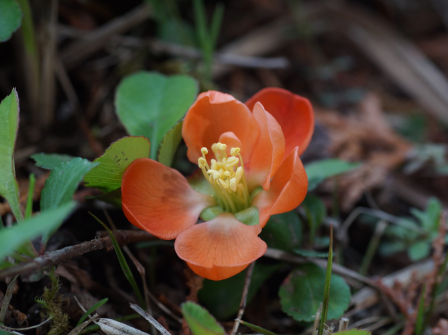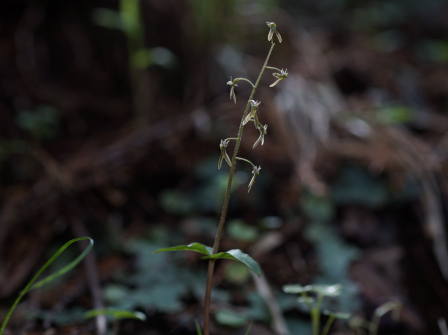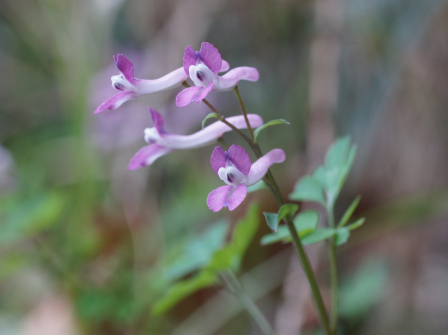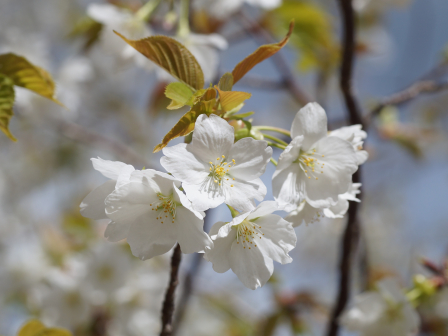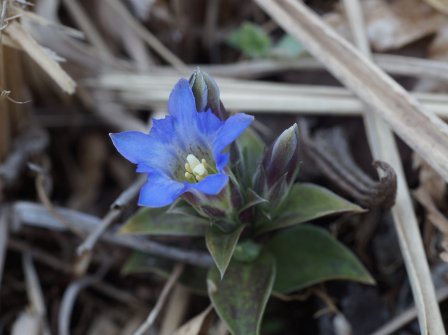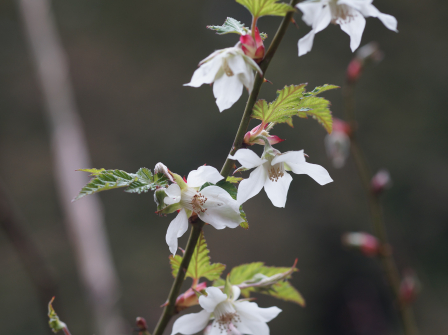フィールド日記
2023.04.14
クサボケ
第1オークヒルでクサボケが咲いています。日当たりのよい草地や雑木林、林縁などに生える落葉低木です。和名は、庭木などとして植えられることが多いボケに似ていて、丈が低いことに由来します。夏から秋にかけて3〜4cmほどの梨のような果実をつけます。
"Kusa-Boke (クサボケ)" trees are in bloom on the First Oak Hill. They are deciduous shrubs that grow on sunny grasslands, wooded areas and forest edges. The name comes from the fact that Kusa-Boke trees are similar to a relative species "Boke (ボケ)", which is often planted in gardens, and that they are shorter than Boke. They bear pear-like 3 to 4 cm fruit from summer to spring.
2023.04.11
ヒメフタバラン
ヒノキ林でヒメフタバランが咲いていました。和名のフタバランは2枚の葉をもつランのなかまという意味です。環境省のレッドリストには載っていないものの、多くの自治体で絶滅が心配されている貴重なランです。
"Hime-Futaba-Ran (ヒメフタバラン)" plants are in bloom in the Japanese cypress woodland. The Japanese name "Futaba-Ran" means orchids having two leaves. Although they are not designated in the Red List of the Ministry by Environment, they are such precious orchids and are considered to be endangered species in many municipalities.
2023.04.07
ジロボウエンゴサク
ジロボウエンゴサクが咲いています。スプリング・エフェメラル(=春のはかないもの)と呼ばれる植物の一種です。スプリング・エフェメラルとは、春、他の草木が生い茂る前に芽を出し、花を咲かせて種子をつくり、他の草木が生い茂るころには地上部は枯れて、その後は地下の球根で次の春を待つような生活を送る植物の総称です。
"Jirobou-Engosaku (ジロボウエンゴサク)" plants are in bloom. They are called "Spring Ephemeral" . "Spring Ephemeral" is a general term for the plants that sprout in spring before other plants spread their leaves. Then they bloom and produce seeds. While other plants grow leaves well, their aboveground parts die and their bulbs underground wait for the next spring.
2023.04.04
ヤマザクラ
ヤマザクラが咲いています。山地に自生するサクラの代表的な種です。公園によく植栽されるソメイヨシノは葉が開くよりも先に花が咲きますが、ヤマザクラは葉と花が同時に開きます。葉はふつう、開き始めに赤味を帯びています。
"Yama-Zakura (ヤマザクラ)" trees are in bloom. They are typical cherry blossoms growing in mountains. Cherry blossoms, called "Somei-Yoshino" and often planted in parks, bloom before spreading their leaves. On the other hand, "Yama-Zakura" trees bloom and spread their leaves at the same time. Their leaves are normally reddish when they start to open.
2023.03.31
タチツボスミレ
タチツボスミレが咲いています。最も普通に見られるスミレです。写真のような咲き始めの時期には目立ちませんが、地上茎があるタイプです。通常は茎に毛がなく、花は淡紫色ですが、毛の有無や色の濃淡には変異があります。

2023.03.28
フデリンドウ
フデリンドウが咲いています。明るい草地や雑木林に生える越年草です。不二聖心のススキ野原は、茶草場として利用されており、不二農園の方々によって毎年冬に草刈りが行われます。そのおかげで、フデリンドウの生育に適した明るい草地が維持されています。
"Fude-Rindou (フデリンドウ)" plants are in bloom. They are biennial plants that grow on sunny grasslands and wooded areas. The grassland on our campus is used as a "Chagusaba (茶草場)", so the farmers cut the grass every winter. Therefore, the grassland is kept as a sunny grassland that is a good place for "Fude-Rindou" plants.
2023.03.24
モミジイチゴ
モミジイチゴが咲いています。モミジの葉のように葉が切れ込み、花は下向きに咲きます。キャンパス内で見られるキイチゴのなかまの中では最も早く咲きます。果実は黄色に熟し、食用になります。
"Momiji-Ichigo (モミジイチゴ)" trees are in bloom. They have lobed leaves like "Momiji (Maple)" trees and they bloom downward. "Momiji-Ichigo" trees bloom earliest in the "Ki-Ichigo (キチイゴ)" group that we can see on campus. Their fruit ripen to yellow and are edible.
2023.03.21
ヒサカキ
ヒサカキが咲いています。強い独特な芳香があり、この時期にキャンパスを歩いていると花を見るよりも先に、匂いでヒサカキが咲き始めたことに気が付きます。雌雄異株で、写真は雄花です。通常は白い花を咲かせますが、写真のようにピンクがかった花を咲かせる個体もあります。
"Hisakaki (ヒサカキ)" trees are in bloom. They have a strong unique scent. Walking on the campus in this season, you can notice they are starting to bloom by their fragrence before seeing their flowers. They are dioecious, and the flowers in the photo are male flowers. They normally have white flowers, but some have pinkish flowers.
2023.03.17
キランソウ
築山の周りでキランソウが咲いています。道端などでよく見られる身近な野草です。地面をはうように広がるようすを蓋に見立てて、ジゴクノカマノフタ(地獄の釜の蓋)という別名を持っています。ちょっと恐ろしい名前ですが、薬草として利用され病気を治す(=地獄の釜の蓋が閉じる)という良い意味が由来のようです。
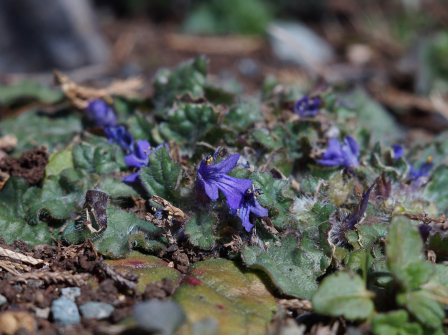
"Kiransou (キランソウ)" plants are in bloom around the artificial hill. They are a common wild flower that can be seen on road sides. They have an alias "Jigokuno-Kamano-Futa (ジゴクノカマノフタ)", as we see them spreading on the ground as a lid. The alias means "Lid of Hell's Cauldron" so it sounds a little scary. However, the alias also implies a the good meaning that they are used as medicinal herb and cure diseases ( = so the plants cover Lid of Hell's Cauldron.)
2023.03.14
ミチタネツケバナ
築山でミチタネツケバナが咲いています。ヨーロッパ原産の帰化植物です。在来種のタネツケバナに似ていますが、茎の途中にはあまり葉をつけないことや、果実が茎や花に寄り添ってつくことなどから見分けることができます。
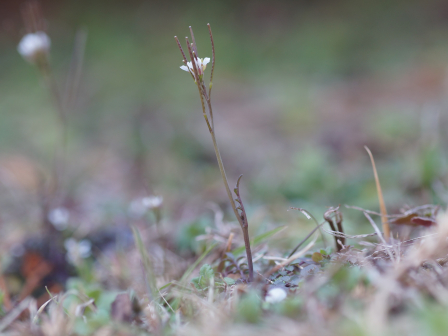
"Michi-Tanetsuke-Bana (ミチタネツケバナ)" plants are in bloom on the artificial hill. They originally come from Europe. They resemble a native species "Tanetsuke-Bana (タネツケバナ)." You can tell "Michi-Tanetsuke-Bana" from "Tanetsuke-Bana" because "Michi-Tanetsuke-Bana" has fewer leaves along its stems and its fruits surround its flowers.


